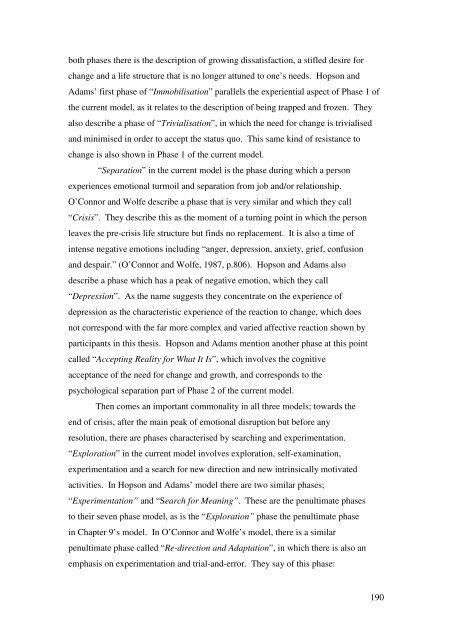DEVELOPMENTAL CRISIS IN EARLY ADULTHOOD: A ...
DEVELOPMENTAL CRISIS IN EARLY ADULTHOOD: A ...
DEVELOPMENTAL CRISIS IN EARLY ADULTHOOD: A ...
Create successful ePaper yourself
Turn your PDF publications into a flip-book with our unique Google optimized e-Paper software.
oth phases there is the description of growing dissatisfaction, a stifled desire for<br />
change and a life structure that is no longer attuned to one’s needs. Hopson and<br />
Adams’ first phase of “Immobilisation” parallels the experiential aspect of Phase 1 of<br />
the current model, as it relates to the description of being trapped and frozen. They<br />
also describe a phase of “Trivialisation”, in which the need for change is trivialised<br />
and minimised in order to accept the status quo. This same kind of resistance to<br />
change is also shown in Phase 1 of the current model.<br />
“Separation” in the current model is the phase during which a person<br />
experiences emotional turmoil and separation from job and/or relationship.<br />
O’Connor and Wolfe describe a phase that is very similar and which they call<br />
“Crisis”. They describe this as the moment of a turning point in which the person<br />
leaves the pre-crisis life structure but finds no replacement. It is also a time of<br />
intense negative emotions including “anger, depression, anxiety, grief, confusion<br />
and despair.” (O’Connor and Wolfe, 1987, p.806). Hopson and Adams also<br />
describe a phase which has a peak of negative emotion, which they call<br />
“Depression”. As the name suggests they concentrate on the experience of<br />
depression as the characteristic experience of the reaction to change, which does<br />
not correspond with the far more complex and varied affective reaction shown by<br />
participants in this thesis. Hopson and Adams mention another phase at this point<br />
called “Accepting Reality for What It Is”, which involves the cognitive<br />
acceptance of the need for change and growth, and corresponds to the<br />
psychological separation part of Phase 2 of the current model.<br />
Then comes an important commonality in all three models; towards the<br />
end of crisis, after the main peak of emotional disruption but before any<br />
resolution, there are phases characterised by searching and experimentation.<br />
“Exploration” in the current model involves exploration, self-examination,<br />
experimentation and a search for new direction and new intrinsically motivated<br />
activities. In Hopson and Adams’ model there are two similar phases;<br />
“Experimentation” and “Search for Meaning”. These are the penultimate phases<br />
to their seven phase model, as is the “Exploration” phase the penultimate phase<br />
in Chapter 9’s model. In O’Connor and Wolfe’s model, there is a similar<br />
penultimate phase called “Re-direction and Adaptation”, in which there is also an<br />
emphasis on experimentation and trial-and-error. They say of this phase:<br />
190
















